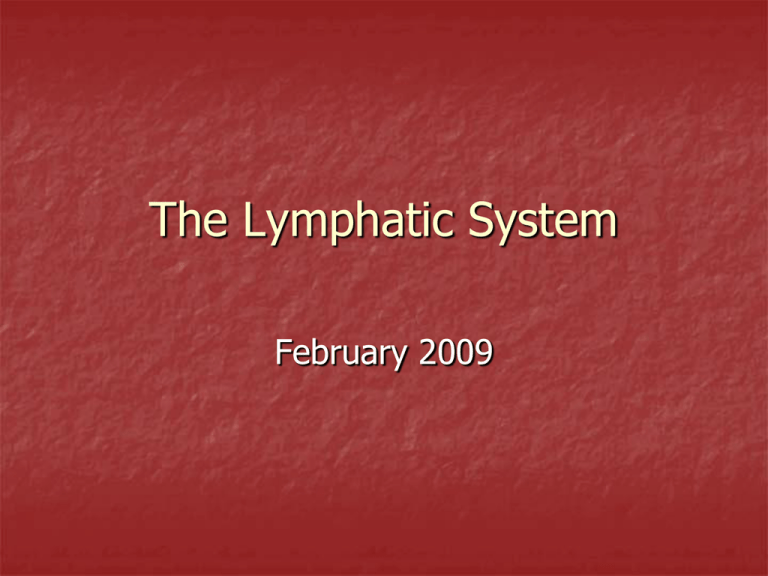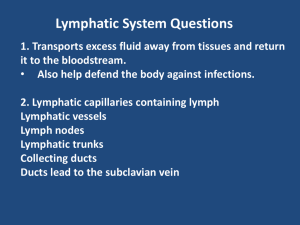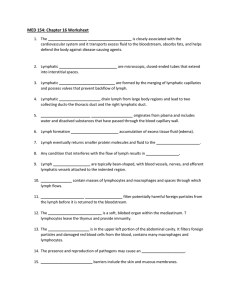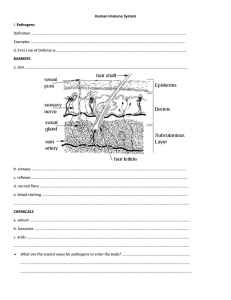The Lymphatic System
advertisement

The Lymphatic System February 2009 Functions drains and filters protein containing fluids from tissue which has escaped from blood capillaries transport fats from gastrointestinal tract to the blood defense – protect the body from foreign cells, microbes, cancer cells Lymph vessels Major Structures of the Lymphatic System Fluid lymph Vessels lymph nodes Tonsils Adenoids Spleen thymus Lymph Organs Structure Details lymph – clear and colorless; composed of water, lymphocytes, nutrients, hormones, and salts; also known as intercellular or interstitial fluid. Originates in blood plasma lymph vessels – carry fluid; more permeable than blood capillaries Lymph Structure Details lymph nodes – small round structures located in lymph vessels; they are located in clusters in the following areas: cervical (neck), axillary (armpits), pectoral (chest), abdominal (stomach), inguinal (groin area), popliteal (back of leg, behind knees) Function: they fight disease by producing antibodies, removing bacteria or malignant cells, and filtering foreign substances; contains large amounts of lymphocytes and macrophages Structure Details tonsils & adenoids- lymph tissue located in the upper portions of the nose and throat spleen – largest lymphatic organ composed of lymph tissue that is located in the left upper quadrant of the abdomen Function: production of B lymphocytes; phagocytizes bacteria and worn out damaged RBC; stores and releases blood in case of demand Structure Details thymus- lymph tissue; located on top of heart, reaches maximum size in puberty and decreases thereafter Function: help produce T- cells Cells of the lymphatic system macrophages – large phagocytic cell (cells eats bad stuff) (like pacman chew it up) lymphocytes – originate in the bone marrow; type of white blood cell that provides immunity Two types T- lymphocytes & B – lymphocytes Macrophage Lymphocytes T lymphocytes – respond to foreign antigens by attaching to the foreign object or cell (interact directly with the cells – called cellmediated immunity); attack cancer cells, but the problem arises when the cancer cells divide faster than the T cells can kill them. 4 types – natural killer T cells cytotoxic t cells – cause apoptosis or programmed cell death memory t cells – remember past antigens for quicker response Suppressor t cells – suppress immune system to prevent over-reaction to known foreign antigens. Lymphocytes Continued B lymphocytes – respond to foreign antigens by producing antibodies that destroy the antigenbearing particles (don’t kill cells directly – called antibody-mediated immunity) B lymphocytes “taste” foreign antigens, so that they can then make appropriate matching antibodies which can attack the foreign invaders. Antibodies (immunoglobulins) – destroy any cell that bearing the matching antigen. Cells of Lymphatic If a microbe that can cause infection gets past your body’s initial barriers (mechanical barrier) First line of defense (skin, mucus), T cells are the army troops that do the fighting (B cells are the armed guards that hold a grudge). Antigen vs Antibody Antigen – proteins, polysaccharides, lipids that are located on a cells surface that elicit an immune response. Chemical markers Self antigens- proteins that the body cells recognize as “self” Non-self- proteins that the body does not recognize Continued… Antibody – protein that B cells produce in response to the presence of a non-self antigen When an antibody combines with an antigen, it renders the antigen-bearing cell/particle inactive and leads to the destruction of the cell. Causes agglutination or massing of cells together so they can be destroyed by mig Agglutination of anitgens with matching antibodies Nonspecific Defense mechanical barrier: physical barrier between the body and pathogen. Ex: skin, mucous membranes, cilia, epiglottis. First line of defense for the body species resistance: a given organism develops diseases that are unique to it. Examples are mumps, gonorrhea and syphilis infect humans but not other animals. Disease may affect different animals differently Nonspecific Defense all except mechanical barrier are second line of defense chemical barrier: enzymes in body fluid that can damage, kill or make the environment uninhabitable for the pathogen. Ex. Gastric juice, tears, salt in sweat fever: endogenous pyrogen (protein) raises the set point in the brain for body temperature. The higher temperature reduces the levels of iron in the blood that the pathogen needs to survive. Also, phagocytic cells attack more vigorously inflammation: redness, swelling, heat, and pain due to a pathogen invasion, inhibits microbial growth. Decreases blood flow through the area. Specific Defense (Immunity) Third line of defense resistance to particular pathogens or to their toxins cell-mediated immunity – this is where T-cells, B-cells, and macrophages are activated. Specific Defense (Immunity) Antibody-mediated immunity Immune responses Primary immune response – B cells and T cells are activated and fight the pathogen. Antibodies are produced (takes 5-10 days to reach detectable levels) Secondary immune response – Some of the B cells activated by the primary response remain dormant as memory cells; if the antigen is encountered in the future, the memory B cells immediately begin to produce the antibody Active and Passive Immunity Active immunity – results when a person produces an immune response to an antigen that is long-lasting Occurs naturally when a person is exposed to a pathogen and develops a disease; person gains resistance by initiating a primary immune response. The primary immune response gives immunity or a secondary immune response. Active Immunity Continued Occurs artificially when a person receives a vaccine (bacteria or viruses that have been killed or weakened so they can’t cause a serious infection); but they still contain antigens that stimulate an immune response; doesn’t always last for life. Still activates a secondary immune response Passive Immunity occurs when a person receives antibodies produced by another individual; person does not have an immune response, so immunity is shortterm Occurs naturally when antibodies pass from mother’s blood into fetal bloodstream, also thru breastfeeding; fetus acquires immunity against pathogens that mother has developed immunity against; lasts 6 months to a year after birth Occurs artificially when a person receives antiserum (ready-made antibodies) Types of Acquired Immunity Type Mechanism Result Naturally acquired active Exposure to pathogens immunity Symptoms of disease and an immune response Artificially acquired active immunity Vaccine Stimulation of immune response without severe symptoms of disease Artificially acquired passive immunity Injections of antibodies (antiserum) Short term immunity without an immune response Naturally acquired passive immunity Antibodies passed to fetus Short term immunity for infant without immune response (lasts 6 mon to 1 yr) Vaccines mixtures of antigens (killed microbes, those that are unable to cause infection, or proteins not recognized as self) Administered orally, nasally, inoculation not for life – usually repeated Immune System Concerns Three types of immune system disorders Autoimmune Diseases Allergies Immunodeficiency's autoimmune diseases – a. your system attacks your own self cells b. Occurs when bacteria/virus causes T cells to attack body’s own macrophage. Eventually killer T cells start to view other cells in the body as foreign c. Ex. Lupus, Rheumatoid arthritis, multiple sclerosis Allergies – a. Allergens cause the system to have a hypersensitivity reaction which causes an excessive immune response. Severity can change year to year and some start late in life – genetics can predispose people to allergies b. Delayed reaction allergy results from repeated exposure to antigens Allergies Continued c. IgE antibodies cause the release of histamine …. Initiating allergic reactions which can damage the tissues in the body d. dilation of blood vessels, increased vascular permeabilty, swelling, contract of bronchial and smooth muscles, increased mucous production Allergies Continued e. the result is severe inflammation- hives, hay fever, asthma, or gastric disturbances f. some are seasonal and others are year round (food) g. A severe allergic reaction (sudden breathing difficulty) is anaphylaxis can cause anaphylactic shock which can lead to death – treatment is an epinephrine injection or tracheotomy. Symptoms of an anaphylactic shock: hives, vomiting, diarrhea, face, tongue and larynx swell Immunodeficiencies (acquired immunodeficiency syndrome) is caused by HIV (human immunodeficiency virus. HIV targets helper T cells, which makes a person infected unable to fight against this virus. Over time, the person is deficient in helper T cells immunodeficiency. It is acquired (rather than induced) via lifestyle choices (unprotected sex, intravenous drug use) or events (blood transfusions) Immunodeficiencies initial symptoms- weakness, recurrent fever, night sweats, swollen glands, weight loss (similar symptoms of the flu) latency period- 5-10 years person feels well, immune system struggles with growing HIV invading cells AIDS (third stage)-opportunistic infection. Those infected don’t die from AIDS, they die due to the flu, pneumonia, etc because their immune system is so weak, they can’t fight anymore.






